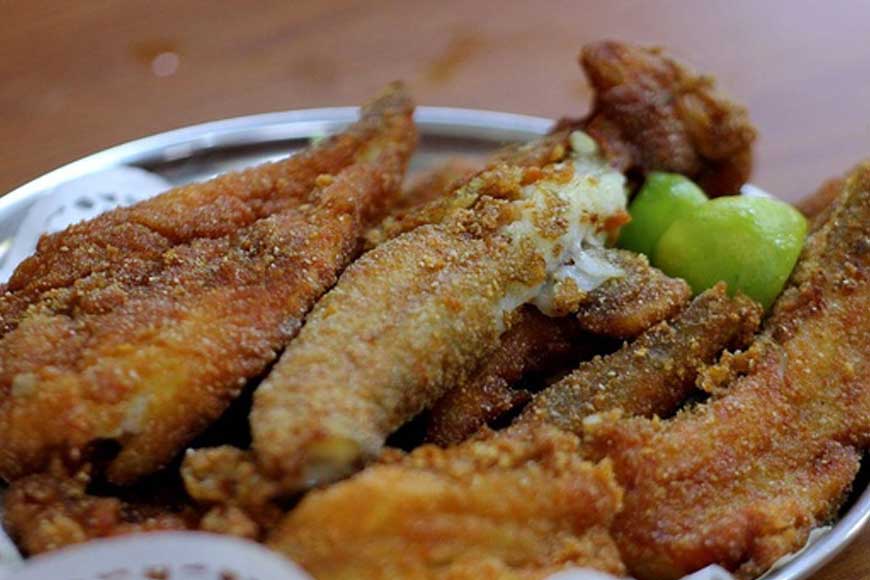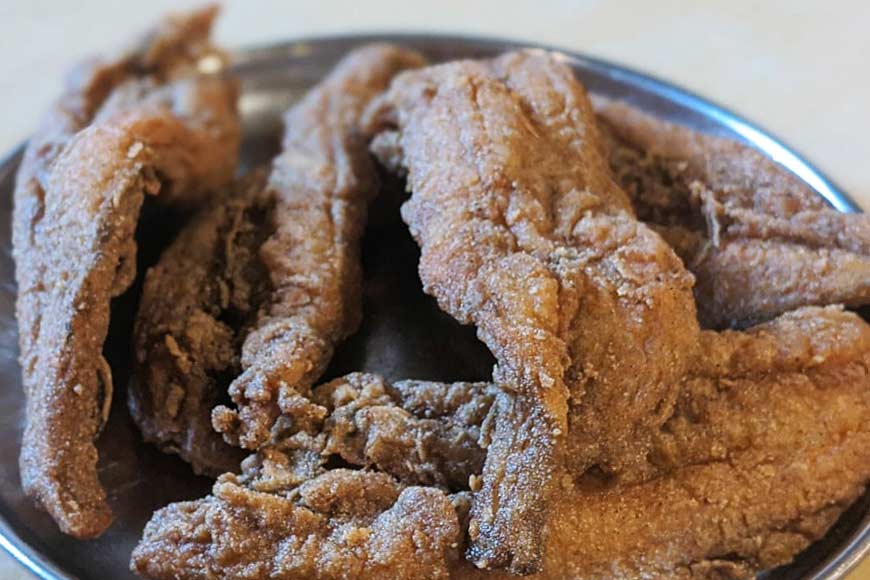Romancing Bengal’s ‘Loitta’ across India

Ranjini Guha is an Associate Professor in History with research interests in Food History. She is author of the upcoming book, Foodscapes, Lockdown and Dinner Diaries
Sea fishes do not top the favourite list of fish lovers in the Eastern part of India, unlike Western coasts where sea fishes are much valued, tasted and experimented with. During the last couple of decades or more sea fishes like Pomfret, Sardines, Mackarels and what we call Loitta in Bengali is seen in the Kolkata markets with regularity as well has gained in popularity. Loitta in particular has been a delicacy with the Bangals (those who lived in East Bengal) for ages. Loitta jhuri (scrambled Loitta) and dried Loitta has been a favourite. What we call Loitta is known as Bombay Duck or Bombil in the western coast of our country. They are much loved along the entire Konkan coast.
With an ancestry from East Bengal and married into a rigid Bangal family, Loitta is one of my favourites too. Spiced up, dry with oil oozing out and with a generous addition of vegetables Loitta jhuri continues to be a delicacy in my house. My recent trip to Bombay where I saw the love for loitta, known as Bombay Duck or Bombill made me realize that distinctions of language, culture can be easily transcended by taste. Tastes are often similar across various distinctions. Labelled as ‘lizardfish’ on Wikipedia, Bombill has a special place in the hearts of all of us.
 Bombay Duck or 'Loitta'
Bombay Duck or 'Loitta'
The soft Loitta has a mythological story associated with its evolution. Legends say that when Lord Rama was building a bridge to Lanka, he sought the help of all the fishes in the sea. With the exception of Bombill all of them obliged. Lord Rama was angered at such an errant behaviour and he threw them into the seas near Bombay but not before crushing it in his palms. This physical torture crushed all its bones and it lives devoid of a backbone for ever. Govind Narayan in his autobiography, - ‘Govind Narayan’s Mumbai: An Urban Biography from 1863’ narrated the story.
Etymologically Loitta is also linked to the Indian Railways during the colonial period. When the rail links started connecting Bombay to Calcutta, Bombill was transported to the Eastern part by the railways. Since the smell of the dried fish was overpowering, the Bombay Mail (or Bombay Daak) smelled fishy. ‘You smell like the Bombay Daak’ became common in use in the days of the British Raj. Bombay Daak eventually was spelled as ‘Bombay Duck.’
The soft Loitta has a mythological story associated with its evolution. Legends say that when Lord Rama was building a bridge to Lanka, he sought the help of all the fishes in the sea. With the exception of Bombill all of them obliged. Lord Rama was angered at such an errant behaviour and he threw them into the seas near Bombay but not before crushing it in his palms. This physical torture crushed all its bones and it lives devoid of a backbone for ever.
According to some historians, the term Bombay duck was first coined by Robert Clive, after he tasted it during his conquest of Bengal. He is said to have associated the pungent smell with that of the newspapers and mail which would come into the cantonments from Bombay. In his 1829, ‘Book of poems and Indian reminiscences,’ Sir Toby Rendrag notes the use of a fish nicknamed ‘Bombay Duck’ and the phrase was used in texts as early as 1815.
Also read : The Sweeter the Better- Foodscapes
Loitta is not just famous in Bengal but considered a delicacy across many communities. Bombay has eternally romanced the Bombay Duck, and it is a favourite of almost all the ethnic communities like Malvanis, Konkanis and the Parsis. In 1795, a Parsi businessperson, Seth Cawasji, presented half a ton of dusty Bombay Duck and 30 dusty Pomfret fishes to a administrator of Bombay. Navroji Framji's 1883 recipe book, Indian Cookery for Young Housekeepers, calls the fish “bombloes” and offers two recipes: one, a dried fish stew with tamarind, ginger-garlic, chilli and fried onion; and the second, a chilli-fry of dried bombloes cooked with turmeric, coriander, pulped tamarind and green chillies. In 1975, Parsi musician-composer Mina Kava gave musical shape to the community's love for the fish by writing a song called Bombay Duck, which begins: ‘Here's a story simple / of a duck with a little dimple / he's the strangest little duck / this little ducky never clucks.’
 Bombay Duck Fry
Bombay Duck Fry
Just like East Bengal cuisine, the Parsi cuisine still has a large repertoire of dishes using Bombill like Sookhi Boomla Ni Akoori, Sookhi Boomla Ni Cutlets, Sookha Boomla ni Chutney and Tareka Boomla. I even managed to get an authentic recipe of Tarapori Patio from Daren Hansotia in Kolkata. Tarapori Patio is best had with khichdi, pav or bhakri. Sweet and sour in taste, the dish originated from a village called Tarapore in Gujrat.
RECIPE OF TARAPORI PATIO
For making the Patio one needs Bombay Duck cut into pieces. One has to grind garlic, cumin seeds and red chilli powder in a paste. In a pan in hot oil, the chopped onions are fried till golden brown. The paste is added and stir fried till oil separates. The fish pieces are added. After sauteing for a while salt and vinegar is added to the gravy. After cooking for about five minutes some vinegar soaked jaggery and water is when the gravy thickens and becomes coated to the fish it can be garnished with coriander leaves and remember to keep the flame low after the fish has been added.










